|
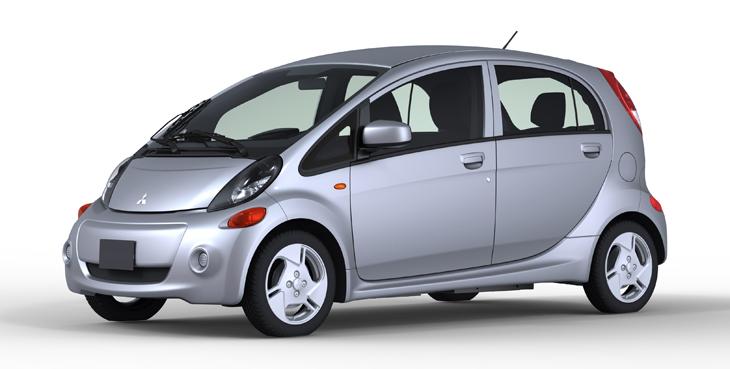
2012 Mitsubishi i - Electric Vehicle
Efficient and Affordable
With a Manufacturer's Suggested Retail Price (MSRP) of $29,125 – a full $6,075 less than electric vehicles produced by other mainstream automobile
manufacturers for the base ES model before a federal tax credit of $7,500 and available state financial incentives (subject to availability of funding),
the revolutionary Mitsubishi i is the most affordably-priced mass-produced electric vehicle available in the United States.
And thanks to its eye-catching design that makes for a surprisingly roomy cabin and excellent handling, stability and safety – accompanied by the
additional benefit of exceptionally low maintenance and "refueling" costs – the all-new Mitsubishi i is an outstanding choice for the eco-conscious
automotive consumer searching for a primary vehicle to supplement their use of ride sharing and/or public transportation, or as an ideal secondary
vehicle for those wanting to make a meaningful personal contribution to sustainable transportation.
Mitsubishi i-MiEV, U.S.-Spec
The next-generation U.S.-specification Mitsubishi i – available in either an ES base model or upgrade SE trim package - will be available to test drive
at dealerships beginning in November 2011 with the first scheduled customer vehicle deliveries set to commence in early 2012.
This new U.S.-spec electric vehicle will feature an even roomier interior and improved safety features, thanks to a 110mm (4.3-inch) wider track and
redesigned front and rear bumpers, a Tire Pressure Monitoring System (TPMS) and an Acoustic Vehicle Alerting System (AVAS) to warn pedestrians of
the approaching EV. A redesigned center console featuring improved materials will also feature prominently on the new North American Mitsubishi i.
This zero tailpipe emission production vehicle makes use of a more powerful 49 kW AC synchronous electric motor (66 bhp), an 88-cell 16 kWh
lithium-ion battery pack and includes an onboard battery charger and is exceptionally "fuel" efficient: The U.S.-spec Mitsubishi i is rated by the EPA
to attain 126 mpg equivalency in city driving and 99 mpg in highway driving and achieves a commanding "real world" EPA driving range of 62 miles (98 miles in the EPA LA4 city unadjusted).
The vehicle's batteries can be recharged in approximately 22 hours by the included 120v Level 1 portable charging cable, 7 hours by a dedicated
240v Level 2 EVSE charger (available for home installation by select retailers or utility companies), and receive an 80% charge in under 30 minutes from a public Level 3 quick charging station via the optional charging port.
Standard appointments on all Mitsubishi i models include a 4 speaker, 100-watt AM/FM/CD audio system with MP3/WMA playback capability;
speed-sensitive Electric Power Steering (EPS); LED taillamps; a driver's seat heater; a highly-efficient electric manual air conditioning system with
micron filter; and a vehicle security and immobilizer anti-theft system. An advanced airbag system consisting of dual-stage front airbags, driver and
front-passenger seat-mounted side-impact supplemental airbags and roof-mounted curtain side-impact supplemental air bags; 4-wheel anti-lock
brakes (ABS) with Electronic Brake-force Distribution (EBD); and Active Stability Control (ASC) with Traction Control Logic (TCL) are also included as standard equipment.
Vehicle options include a Cold Zone package that includes heated outside mirrors and a battery warming system for the main lithium-ion battery pack
($150 MSRP) and a Premium Package available with the upgrade SE trim level that includes an HDD navigation system with rear view camera, DC
quick charging port and the FUSE Hands-free Link System™ with USB port and steering wheel-mounted audio controls ($2790 MSRP).
At-A-Glance
The breakthrough Mitsubishi i is the most affordable 100% electric-powered mass-market production vehicle available in North America. Its net MSRP*
after federal tax credit is a very affordable $21,625 for the standard ES model and only $23,625 for the upgrade SE version, making the starting price
for the all-new Mitsubishi i several thousand less than other mass produced electric vehicles available in the market.
Powered by Mitsubishi innovative Electric Vehicle (MiEV) technology, the rear-wheel drive vehicle's drive system includes a 49 kW (66 bhp) AC
synchronous electric motor; an 88 cell, 330V lithium-ion battery pack for a peak storage of 16 kWh; and a single fixed reduction gear transmission.
This electric motor is capable of producing its peak torque of 145 lb. ft. almost instantaneously when accelerating from a standstill; the vehicle has a top speed of approximately 80 mph.
This electric vehicle's (EV) shift selector allows the driver to choose between three different drive settings in order to optimize driving fun, increase
driving efficiency or to amplify energy recycling from the vehicle's regenerative braking system:
"D"-position
Allows the driver to experience maximum performance as it generates 100% torque in direct response to accelerator input.
"Eco"-position
Helps to reduce the rate of battery consumption to maximize "energy" economy.
"B"-position
Increases the regenerative brake biasing to augment energy recycling (power production is the same as in the "D" position).
The Mitsubishi i can be recharged using three advantageous methods: A 240V/15A Level 2 home EVSE Eaton charging system (estimated charge time
from completely empty battery to fully charged – 7 hours; charging method recommended by Mitsubishi), a CHAdeMO Level 3 public quick charging
station (estimated charge time from very low battery to 80% full – 30 minutes; requires optional DC charging port available as an option), and
through the conventional 120V/8A Level 1 portable charging cable that plugs into a standard wall outlet (estimated charge time from very low battery to full charge – 22.5 hours; included on all Mitsubishi i models),.
The driving range of the Mitsubishi i is a very robust EPA "real world" rating of 62 miles/charge. All Mitsubishi i models come with an 8-year/100,000 mile battery warranty.
The Mitsubishi i may be compact in its overall dimensions, but this EV's clever packaging and design make for very roomy and comfortable
accommodations for four adult-size passengers. With its relatively tall roofline, rear-mounted electric motor and battery pack placed safely and
securely in a watertight, stainless steel safety cell underneath the floor of the passenger compartment, even the rear passengers will experience an
exceptionally satisfying degree of legroom. There's even a small cargo area at the back of the vehicle that is more than capable of carrying numerous
bags of groceries or purchases from the local mall. And with the 50/50 rear seats folded flat, the cargo capacity expands greatly, allowing the
Mitsubishi i to become the preferred vehicle for weekend trips for bulkier items at a discount warehouse or home improvement retailer.
Comfort and convenience features included on every Mitsubishi i include energy-efficient HVAC systems consisting of an electric manual air
conditioner with micron filter and an electric compressor cabin heater, a driver's side heated seat, power windows/mirrors/door locks, a
sweet-sounding 4 speaker 100-watt AM/FM/CD audio system with MP3/WMA playback, auxiliary 12V DC power outlet, 3-spoke steering wheel, floor
mats, vehicle security system and the very clever MiEV remote system that allows the battery pack to be charged via timer as well as pre-activating either the air conditioning or heater.
Optional features available on the upgrade SE trim model include a Premium Package ($2790) that includes an HDD navigation system with rearview
camera, FUSE Hands-free Link System™ with USB port and handy steering-wheel-mounted audio controls, and a DC quick charging port that allows
the Mitsubishi i battery pack to be rapidly recharged from one of the many Level 3 chargers that are installed around North America (with more being
installed every day) – only 30 minutes to take a very low battery level all the way up to 80% full!
Residents of cold climate regions (ambient temperatures that can drop below zero degrees Fahrenheit) are strongly recommended to take advantage
of the very reasonably-priced Cold Zone package ($150) that includes a Li-Ion Battery Warming system and heated outside side mirrors. This package is available on both ES and SE trim levels.
Standard safety features on every Mitsubishi i include anti-lock brakes (ABS) with Electronic Brake-force Distribution (EBD) and Brake Assist (BA);
brake override system; Active Stability Control (ASC) and Traction Control Logic (TCL); Tire Pressure Monitoring System (TPMS); and advanced dual
front air bag supplemental restraint system (SRS), side air bags and side curtain air bags. Specialized EV-related safety items include a high-voltage
cut-off system and an Approaching Vehicle Audible System (AVAS) to help alert pedestrians to the approaching vehicle.
Mitsubishi anticipates an initial rollout of their game-changing EV into its dealership network in California, Oregon, Washington and Hawaii by
November 2011, followed by the northeastern U.S. market by March 2012 with nationwide availability expected by December 2012.
*Includes federal tax credit of up to $7500. Retail MSRP of ES starts $29,125 and SE starts at $31,125
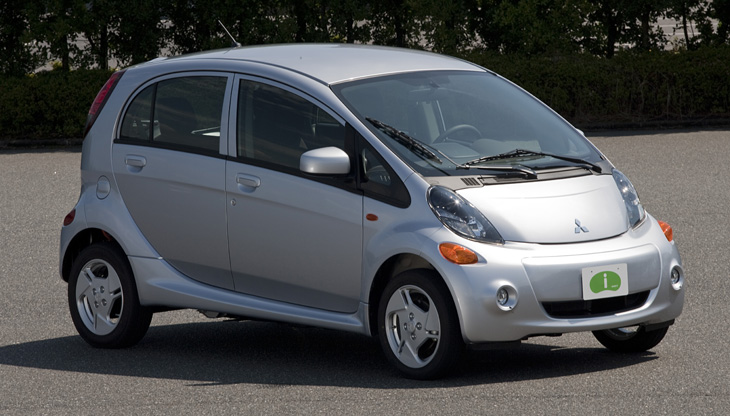
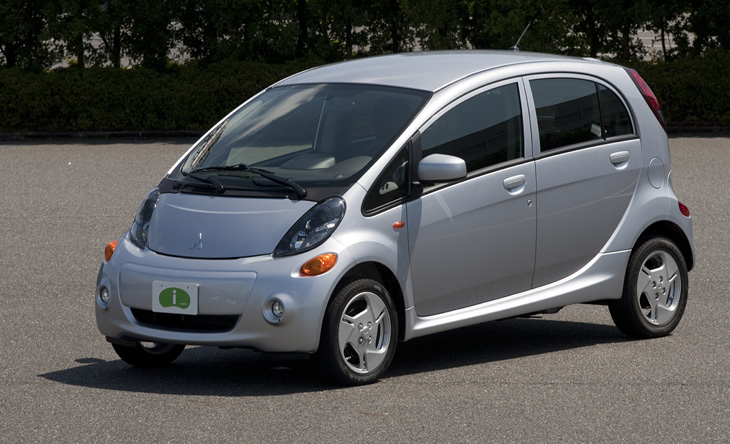
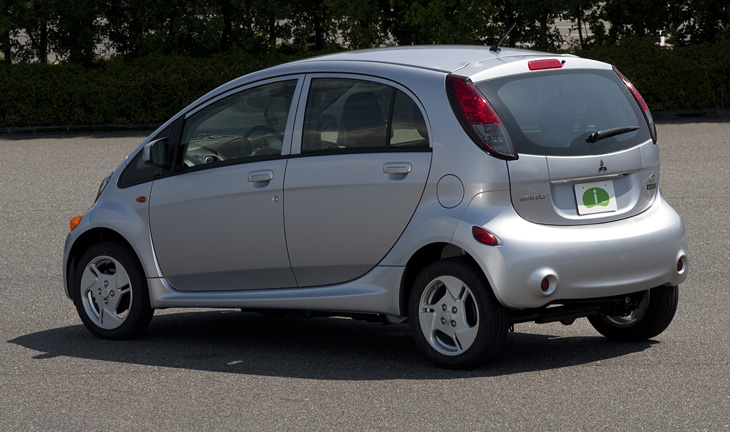
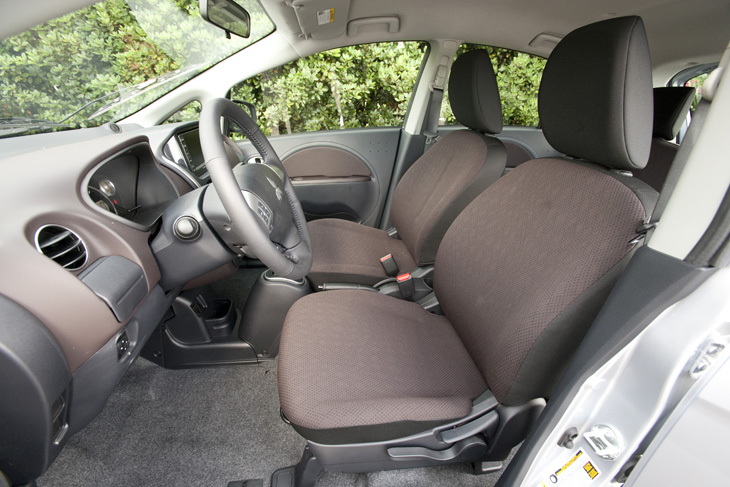
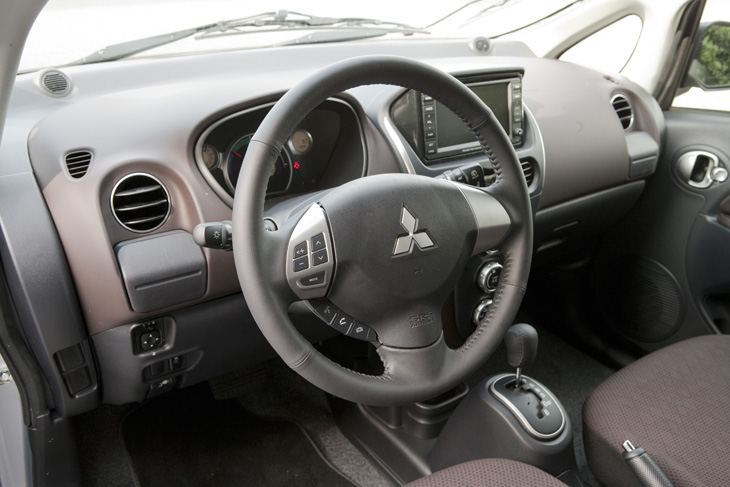
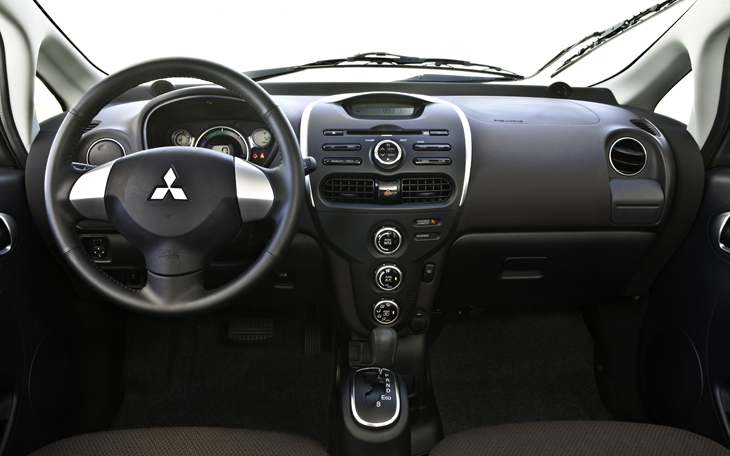
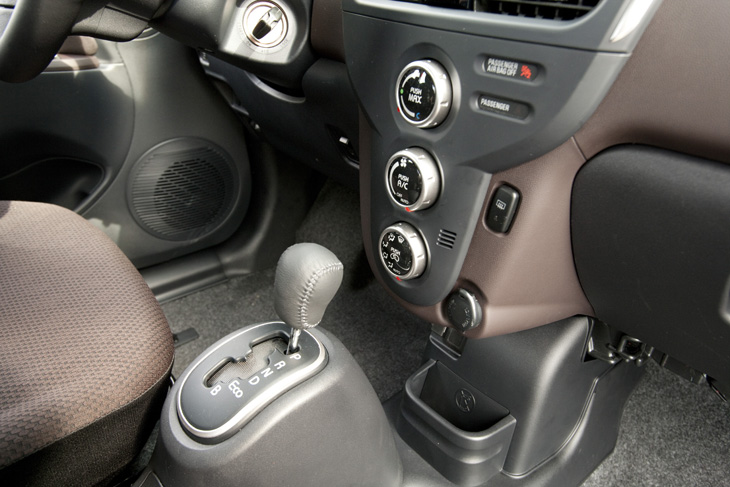
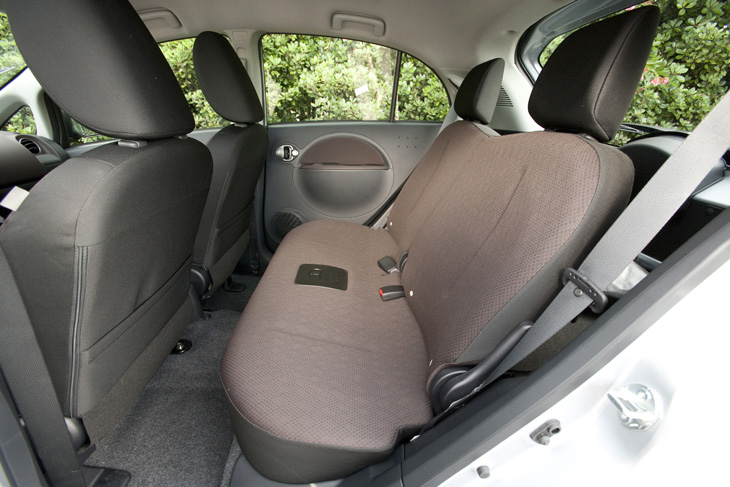
Interior
Premium two-tone interior comes standard on the 2012 Mitsubishi i SE trim level
Redesigned Interior
The 2012 Mitsubishi i features a thoughtfully redesigned interior for the North American marketplace that features a new upscale aesthetic and makes
the most of the reconfigured vehicle's wider dimensions.
Highlights for Mitsubishi's new EV include two distinct trim levels for both the entry-level ES and the premium SE versions of the vehicle, additional
information displayed in the driver's gauge cluster, handy new pocket storage bins, utilization of new environmentally-friendly materials and the
adoption of Mitsubishi's convenient MiEV remote system as standard while offering upscale options including HDD navigation with FUSE Handsfree Link
System™ that allows the operation of an iPod® docked via USB input or a Bluetooth® enabled cell phone simply by voice commands.
Center Console
Center Console design of the 2012 Mitsubishi i SE with Optional HDD Navigation System
Entry-level ES Trim Level
Designed using quality plastics with good tactile feel, the layout of the center console and its accompanying controls provide both the driver and the
front passenger excellent ergonomics and intuitive operation of all of its switchgear.
Located at the top of the center stack of the entry-level ES model of the 2012 Mitsubishi i is a convenient segment display (approximately 1 in. tall and about 5 in. wide) that displays such information as audio channels.
Immediately below this display is a sensuous sounding 4 speaker, 100-watt AM/FM/CD sound system with MP3/WMA playback capability with a large,
centrally-located volume knob with a pair of inset switches to control such audio system functions as "Play," "Repeat," "Forward" and "Reverse." To
the left of this volume knob bar buttons for selecting either the CD player or radio, to the right of the volume knob bar buttons for changing the audio system's display and menu.
The button that activates or disables the vehicle's flashing hazard lights can be found just below the audio system's large volume knob, with large manually-adjustable HVAC vent openings positioned on both sides of this switch.
A key design feature of the North American-spec 2012 Mitsubishi i can be found in the layout of the HVAC controls. While both the Japanese and
European-spec versions feature air conditioning and heating controls positioned in a horizontal layout, the North American version of the car has the
trio of HVAC knobs placed vertically. This gives the driver and front passenger more knee room and an improved feeling of spaciousness for both front occupants.
Residing beneath the HVAC controls at the bottom of the center waterfall and it just in front of the gearshift lever is a small open storage bin, 12-volt outlet and USB port when equipped with the Premium package.
At the outer perimeter of either side of the dashboard (closest to the A-pillars) are another set of HVAC vents accompanied by a useful pair of sturdy
flip-down cup holders (one on the driver's side, one on the front passenger's side). Beneath the driver's side vent/cup holder is the side mirror of adjustment switchgear and the traction control off button.
Premium SE Trim Level
The center console found in the premium SE trim grade builds on the stylish and highly functional arrangement found in the base model vehicle but adds an additional level of refinement and aesthetic appeal.
Most notable is the eye-catching coffee-colored surface that features prominently across the majority of the dashboard, flowing downward to
surround the entire center stack that is now colored in a deep, rich ebony hue. The trio of HVAC control dials - now done up in bright silver - contrast vibrantly against their black background.
Other stylish accents include bright silver-colored rings for the main gauge face on the driver's instrument panel as well as the round HVAC vents.
The outer sections of the center console also receive the visually appealing silver trim treatment.
Additional upscale interior treatments found on the SE level vehicle include a leather wrapped steering wheel and shift knob, new door trim with cloth inserts and upgrade seating surface material.
Instrument Panel
The Instrument Display of the 2012 Mitsubishi i includes many new details for the North American market
Though similar in its overall appearance to that of its European equivalent, the instrument display features several new illuminated icons for the U.S. and Canadian markets.
These include
Tire Pressure Monitoring System (TPMS)
Acoustic Vehicle Alerting System (AVAS)
Service Reminder
Freeze Warning Reminder
Regenerative Braking System (RBS) Service Reminder
Highly efficient, lightweight yet powerful, and proven to be reliable to the extreme, the electric powertrain that provides the motive force for the
all-new 2012 Mitsubishi i is a paragon of engineering excellence and is an evolution of the Japanese auto manufacturer's highly developed electric
motors and accompanying transmissions that have powered the company's groundbreaking 100% battery-powered electric vehicles through its rich history.
Seating Design & Safety Highlights
Design
•Weight savings with new lighter front passenger occupant classification sensor
•New environmentally-friendly plant-derived seat surface material
•Natural cotton yarn in seating surfaces reduces C02 emissions compared to PET textiles
Safety
•Height-adjustable driver and front passenger seatbelt anchors
•Redesigned rear seat headrests for reducing whiplash injuries
•Driver seat position sensor and front passenger's occupant classification sensors for the advanced air bags
Rear Seating and Cargo Area
Thanks to its exemplary interior space efficiency that makes the most of the car's relatively compact dimensions, the cabin design of the 2012
Mitsubishi i offers rear passengers a high degree of both headroom and legroom in a comfortable seating arrangement for two adults.
The rear cargo area located behind the backseat offers enough volume to easily accommodate multiple bags of groceries or purchases at a local shopping center while still offering plenty of room for four adults.
Need more room? No problem. Thanks to the vehicle's 50/50-split fold-down and reclining rear seats, expansive rear opening and lightweight
hatchback door, Mitsubishi's versatile i-MiEV has over 50 cubic feet of rear cargo volume.
Convenient MiEV Remote System
A standard feature on every 2012 Mitsubishi i model, the MiEV Remote System acts as a virtual assistant that aids communication between the
vehicle and its owner, allows the vehicle's operator to pre-program and automate several key electric vehicle-related tasks.
These include:
•Pre-activation of the Climate Control
•Timed Battery Charging
•Battery Level Information
•Battery Warming
Pre-activation of the Climate Control
The MiEV Remote System hand-held controller can be used to remotely control the vehicle's climate control system to activate the air conditioning,
heater or defroster. This allows the vehicle's owner to pre-heat or pre-cool their Mitsubishi i while it is still plugged in at their home or place of work, thus conserving the lithium-ion batteries and maximizing driving range.
Selectable climate control modes include "COOL," "HEAT," "DEF" (when the defroster setting is selected this activates the rear window defrost her as well) and "A/C OFF."
When choosing the "HEAT" setting, the vehicle's operator must remember to manually switch the driver's seat heater (located on the console below
and to the right of the steering column) on in advance so that the seat may be warmed by the MiEV Remote System.
The air conditioning can be pre-activated to start up to 30 minutes before driving (the pre-activated A/C will automatically shut off after 30 minutes
of operation) and is especially beneficial in warm climates where the vehicle can take advantage of being pre-cooled while parked in a shaded area
such as a garage, a parking structure or beneath a covered carport. Pre-activating the air conditioning will only occur if the vehicle's lithium-ion battery level on the remote display has one or more dots.
Timed Battery Charging
The MiEV Remote System hand-held controller allows the EV's owner to set two charging timers to automate the charging of the car's lithium-ion
battery pack. One timer controls the actual time that the system should begin the charging of the batteries while the other controls the duration of the charging time.
In many regions, a Mitsubishi i owner can take advantage of lower electric utility rates by setting their vehicle to begin charging its lithium-ion
battery pack in off-peak hours (for example by starting at 12:00 midnight) to save even more money than what the already remarkably low "refueling" costs are with a 100% electric-powered vehicle.
As for the duration of the automated time for the battery charging, the MiEV Remote System allows the charging time to be set for anywhere
between zero and 19.5 hours. When the system detects that the lithium-ion battery pack has reached full charge (for example, prior to full 19.5 hour timed charge duration) it will automatically cease the charging cycle.
If a Mitsubishi i is not set for automated timed charging, a vehicle's owner can begin charging the vehicle remotely at their discretion by manually
activating battery charging and setting the charge timer duration (for example, 6 hours) via the MiEV Remote System hand-held remote.
Battery Level Information
The MiEV Remote System hand-held controller features a visual battery level display so that the vehicle's owner can remotely check the current
charge level of the lithium-ion battery pack.
Battery Warming
In cold weather, the MiEV Remote System allows the vehicle's lithium-ion battery warming system ($150; part of the Cold Zone Package that includes
heated side mirrors) to pre-warm the battery pack every 6 hours when the EV is not being driven. This greatly improves battery longevity in harsh winter climates throughout the United States and Canada.
Additional MiEV Remote System Features:
One (1) MiEV Remote System hand-held controller is included free of charge with every vehicle; up to four (4) controllers can be programmed to work with each vehicle.
The MiEV Remote System hand-held controller has an effective operating range within 300 feet of the vehicle.


Highly Efficient Heating/Air Conditioning System
In keeping with the efficient nature of the 2012 Mitsubishi i, the company has developed a novel heating/air conditioning (HVAC) system that reduces
electrical power consumption while providing comfortable and highly effective climate control within the cabin.
Cooling System
The cooling system features an electrically-driven air conditioning compressor that is integrated with the vehicle's inverter, with the inverter cooled
by suction refrigerant. While this refrigerant agent is of a common type (HFC-134a), the refrigerator oil is specially-designed for use with the electric A/C compressor.
Of note, the heater unit (evaporator) and condenser are carryover from the internal combustion-powered version of the Mitsubishi i.
This configuration, accompanied by a very precise compressor speed control unit, allow the occupants of the 100% electric-powered Mitsubishi i to
experience air conditioning nearly equally effective to that of its internal combustion-powered sibling while greatly reducing energy consumption.
Heating System
The heating system relies on an electric water heater and a coolant cycling system to provide the passenger compartment with a more than
adequate supply of warmed air to the passenger compartment that maximizes energy usage by variable control of the electric water heater.
While the coolant cycling system duties are shared between cooling the vehicle's electric motor and the heating system, there are two separate coolant circuits to address each responsibility.
When the heating system is operated in an environment with a low outside temperature, the system improves the efficiency of warming the cabin by mixing some of interior recirculated air with the fresh incoming warmed air.
The heater unit (heater core) is the same one found in the internal combustion-powered Mitsubishi i.
HVAC Control Panel
The climate control of the 2012 Mitsubishi i is a manually-operated system with 6 different positions for heating and cooling.
The top knob controls temperature adjustment; depressing the inner section of the knob engages/disengages the "MAX" heating or air conditioning
system settings. Note: extended use of the "MAX" climate control setting in either cooling OR heating mode while driving will decrease range capability.
The middle knob controls fan speed for both heating and cooling. Depressing the inner section will activate or deactivate the air conditioning.
The bottom HVAC system knob determines the routing of the heated or cooled airflow towards the driver and passengers and also the defrosting of the windshield.
Available HDD Navigation System with Rear View Camera
Included as part of the Premium Package ($2790) available on the 2012 Mitsubishi i SE trim level is a 40GB HDD navigation system with real-time
traffic information, rear view camera system and a music server capable of storing up to 3,000 songs.
Featuring a large, 7-inch LCD screen and user-friendly touch-panel operation, the navigation system contains comprehensive NAVTEQ digital map
data for North America, Hawaii, Alaska, Puerto Rico and the Virgin Islands. The map data is available in three languages: English, French and Spanish.
Among the navigation system's numerous features are thousands of Point of Interest (POI) categories (restaurants, gas stations, post offices, etc.),
a calendar function, a speed-compensated navigation voice volume function, and the availability of High-Occupancy Vehicle (HOV) carpool lanes. An
especially valuable feature is the dedicated real-time traffic feature that is provided by NAVTEQ Traffic with no subscription fee for the lifetime of vehicle.
The system also incorporates a rear view camera display when the vehicle is engaged in reverse gear that details an on-screen guideline of the vehicle's intended path when backing up.
Available FUSE Handsfree Link System™
Another feature of the upgrade SE trim level's Premium Package ($2790) is the FUSE Handsfree Link System™ that gives users the ability to operate
the vehicle's Bluetooth® enabled cellular phone, iPod® or USB thumb drive simply by the sound of their voice.
Simple voice commands are all that are necessary to initiate a variety of functions including playing a favorite song by artist, genre, album or playlist.
What's more, as your digital music collection grows as you add new songs and artists, the FUSE System will recognize the new content thanks to free downloadable updates of Gracenote® digital music recognition software.
The FUSE Handsfree Link System™ supports Bluetooth 2.0 and A2DP technology so you can make hands-free calls with a Bluetooth®-enabled cell phone or stream music from a Bluetooth®-enabled digital music player.
In North American markets, the FUSE System recognizes U.S. English, American Spanish and Canadian French.
Other tasks that can be performed by FUSE include:
Phone:
"Dial" – Make a phone call by saying the individual digits of a phone number
"Redial" – Redial the last outgoing call
"Phonebook" – Store up to 32 phonebook entries that can be looked up and dialed by voice. Up to 1,000 phone book entries can be imported from a
cell phone and accessed through the navigation display screen
Bluetooth® streaming audio:
Bluetooth® streaming audio is compatible with the following navi buttons (if Bluetooth® audio devices support these features): "play," "stop,"
"rewind," "fast forward," "repeat," "scan," "random," "display music name," "artist name" and "album name." It can also display "music name," "artist name" and "album name."
USB input (iPod® player or memory stick):
Voice commands can be utilized to open a playlist, search genre, artist or album
Navigation display screen:
The navigation screen can show the status of a mobile phone including Bluetooth connection, battery level, roaming and signal strength.
*Note: Some of the illustrations and components shown may be subject to design changes by the time the 2012 Mitsubishi i enters production.
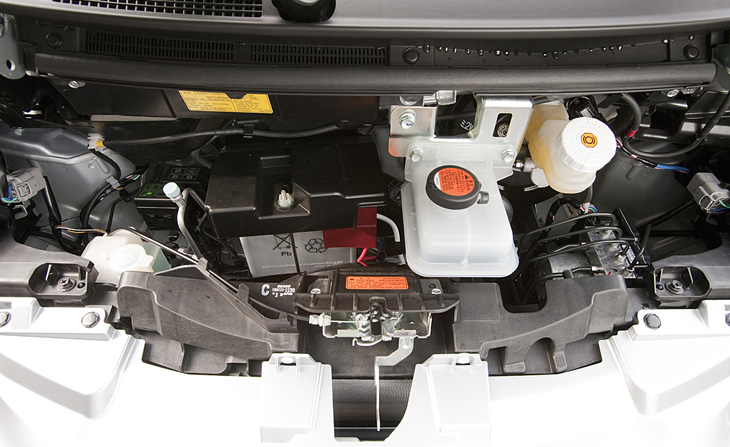
EV Motor/Transmission
The high-tech Electric Motor in the 2012 Mitsubishi i, Electrifying the Automobile – A "Joule" of an Idea
Highly efficient, lightweight yet powerful, and proven to be reliable to the extreme, the electric powertrain that provides the motive force for the
all-new 2012 Mitsubishi i is a paragon of engineering excellence and is an evolution of the Japanese auto manufacturer's highly developed electric
motors and accompanying transmissions that have powered the company's groundbreaking 100% battery-powered electric vehicles through its rich history.
The main components that make up the drivetrain for the North American-spec Mitsubishi i include:
•Electric Motor
•Fixed Reduction Gear Transmission
•Motor Control Unit (MCU)
Electric Motor
Weighing all of 108 lbs., the electric motor powering the 2012 Mitsubishi i features numerous high-tech elements that aid in the area of efficiency, performance and reliability.
Adoption of a synchronous permanent magnetic motor design helps to reduce weight and makes for an electric motor of more compact dimensions.
Electric motor reliability is also improved through the use of an advanced neodymium magnet - far and away the strongest type of permanent magnet
for use in an electric motor. Also adding to the electric motor's durability and efficiency are a highly-effective water-cooling system along with a
high-performance casing that is not only dust resistant but also completely waterproof.
Noise, vibration and harshness (NVH) produced by the electric motor have been all but eliminated thanks to computer-aided design and analysis.
As a result of its advanced design and extensive testing and development, the electric motor in the Mitsubishi i is completely maintenance-free and backed by 5-year / 60,000 mile power train warranty.
Refined yet Lively Powertrain Performance
In its home market, the diamond-star-badged car builder sells both an electric and gasoline-powered turbocharged version of the subcompact
Mitsubishi i. And while the latter version of the vehicle is known for its peppy performance (especially for the small 660cc displacement of its
three-cylinder engine) in the tiny kei car vehicle class in Japan with a full 63 bhp and 69 ft.-lb. (47 kW and 94 Nm, respectively) on tap, the all-new
North American-spec Mitsubishi i with MiEV technology (Mitsubishi innovative Electric Vehicle) betters its internal combustion sibling thanks to an
electric motor that produces nearly 49 kW (66 bhp) at 3000 to 6000 rpm and 196 Nm (145 ft-lb) of torque from 1 to 300 rpm. Because all 145 ft-lb
of torque are available at any rpm, standing start acceleration is ideal for stop-and-go urban (city) driving conditions. Maximum rotation speed of the electric motor is 9900 rpm.
Mitsubishi i Electric Motor power distribution
Yet whether accelerating or decelerating, extremely smooth vehicle operation is assured as a result of the single fixed speed transmission -
occupants inside of the 2012 Mitsubishi i will never experience the sort of momentary hesitation/quiver that occurs in a manual or automatic transmission with multiple gears.
Transmission
Cutaway view inside the compact Transmission of the 2012 Mitsubishi i
Compact in size and weight yet offering excellent performance and refined operation, the fixed gear ratio transmission of the 2012 North
American-spec Mitsubishi i is engineered to make the most of the electric motor's high torque output and a wide power band.
The 7.065 gear ratio has been selected for use in this transmission as research and testing has determined this to be the best ratio for optimum
dynamic performance from the electric motor. This fixed gear ratio, along with a simplified two-stage parallel shaft reduction and a conventional differential unit, distribute motor torque to the vehicle's rear wheels.
Other technical highlights include a single open-type ball bearing that helps to reduce drag and an output shaft layout position that helps to reduce friction of the transmission.
Strong yet sturdy, this remarkable transmission measures less than 7 inches in length and weighs less than 42 lbs. when mated to the electric motor,
the combined transmission/motor measures less than 19 inches long and only weighs 143 lbs - a fraction of the weight of the typical internal combustion engine and transmission pairing.
ComponentOverall LengthWeight
12MY NAS i MiEVMotor + Trans306mm + 172.5mm =478.5mm46kg + 19kg =65.0kg
The Transmission (L) and the Electric Motor (R) weigh a combined 143 lbs.
Motor Control Unit (MCU)
The Motor Control Unit (MCU) is a critical component of a 100% electric-powered vehicle as it manages and regulates the electrical power supply to
the electric motor to generate the necessary level of torque to power the vehicle by converting the battery packs DC voltage into three-phase AC.
Conversely, the MCU is responsible managing the electrical energy that is produced by the regenerative braking system and is fed back into the lithium-ion battery pack.
The Motor Control Unit (MCU) of the 2012 Mitsubishi i
In propulsion mode (drive), the MCU generates the three-phase AC current dataset into the coil of the electric motor to generate a magnetic field.
The motor is rotated by synchronizing the magnetic-field of magnets with the magnetic-field of coil current and with speed sensing position of the
rotor. The MCU controls motor torque by adjusting the magnetic-field of the coil current.
The attraction and repulsion that takes place between the rotating magnetic field and the magnets within the electric motor generates the acceleration torque.
In regeneration mode (braking), the MCU generates deceleration torque by adjusting the phase of electrical current and feeding the regenerative
energy back into the main drive lithium-ion battery pack. In this phase, the electric motor essentially becomes a generator.
The critical electrical components housed within the Motor Control Unit are a smoothing condenser to help stabilize the DC current, several
insulated-gate bipolar transistors (IGBT) that convert the DC electrical current into AC, a heatsink to provide cooling/heat dissipation and a control
board that supervises the electric motor. The control board is located in a separate area within the MCU from the smoothing condenser, the IGBTs and the heatsink to protect it from the heat generated by these components.
The Motor Control Unit measures 11.3 inches wide, 12.2 inches long and 6.7 inches tall and weighs 33 lbs. and, like the vehicle's electric motor, is
housed a completely waterproof and dustproof structure and makes use of water-cooling for temperature control.
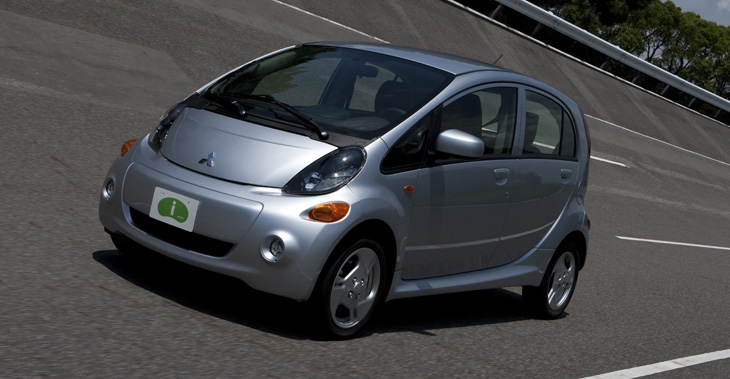
Extending Your Driving Range
Driving range of a 100% electric-powered vehicle like the 2012 Mitsubishi i can vary greatly based on how the vehicle is driven and operated. Here
are some tips for extending your driving range.
Before you Drive
- Check tire pressure regularly. Underinflated tires create more rolling resistance and waste electric "fuel."
- Extra weight means more electricity usage so if there's any unnecessary dead weight in the vehicle, take it out and leave it at home.
While you Drive
Shift Position, Selecting the most suitable shift position is important for extending your range.
- "D" is the standard mode and provides full power access and normal regenerative braking effort.
- "Eco" slightly reduces overall power output thus conserving energy and slightly increases the regenerative braking capability.
- "B" provides full power with the strongest calibration of regenerative braking capability.
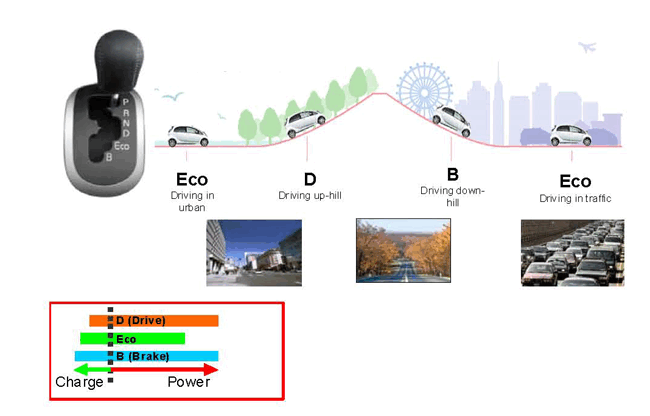
Stepping on the Accelerator
Drive smoothly, accelerate gently and read the road ahead.
You may check your real-time energy consumption by looking at the power meter. Try to keep the red needle within the green "Eco" zone. When the
vehicle is braking (regenerating energy), the red needle should be in the blue "Charge" zone.
- When you are driving on freeways, set a desired speed at or near the speed limit and try to keep a consistent speed. The faster you go, the greater the energy consumption.
- When decelerating, try to release your foot off the accelerator pedal as early as possible. The moment you release your foot off the pedal, the
vehicle will start regenerating electricity and is especially effective when you are driving downhill.
- When driving uphill, try to carry as much speed (momentum) from the flat section of road up the hill as possible to avoid having to accelerate in the middle of the hill.
Use of Climate Control
As the climate control is powered with electricity provided by the main drive lithium-ion batteries, you can increase your driving range by conserving electricity usage.
- Use the MiEV remote system for pre-heating, cooling and using the defroster as much as possible. That way the vehicle's passenger
environment can be primed (climate-controlled) while plugged into the wall outlet without drawing electricity from the main battery.
- If you are driving alone in the winter, use the seat heater instead of the cabin heater. The seat heater is a much more energy efficient way to keep warm.
- The MAX switch is effective for adjusting the cabin temperature in short order. However, the electricity consumption is large. Once the
temperature is adjusted to your liking, it is better to turn off the Max switch to reduce unnecessary energy consumption.
- Available side window deflectors allow you to open your window a few inches and can keep the fresh air circulating even when it's raining
Caution
The headlamps, windshield wipers, Approaching Vehicle Alert System (AVAS) and other electric devices are operated by the 12V auxiliary battery and
do not have a significant impact on driving range. Please prioritize your safety and keep these safety features on while operating your Mitsubishi i.
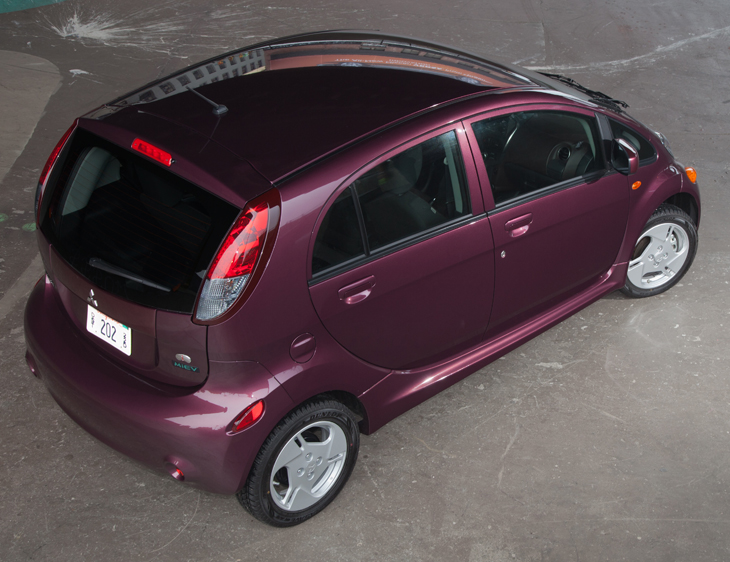
Chassis
The 2012 Mitsubishi i can comfortably seat four adults
Compact in size yet amazingly space efficient and structurally sound, the 2012 North American-spec Mitsubishi i 100% electric-powered vehicle is
based on a platform that has served tens of thousands of consumers well in markets around the globe.
From such diverse locales (both culturally and geographically) as the Pacific Rim to the Middle East, the United Kingdom to Australia, owners have
come to love the affordability and practicality that the gasoline-powered version of the Mitsubishi i has to offer. The same can be said of the battery
electric version of the vehicle as well: In less than two years, the Mitsubishi i EV has already sold over 10,000 units in its home market and across Europe.
Redesigned Body for Increased Roominess
The North American spec 2012 Mitsubishi i is both wider and longer than its Japanese and European-spec predecessors. While much of its additional
length (145 in. overall – an increase of nearly 8 in.) can be attributed to the accommodation of larger bumpers front and rear, the vehicle's interior
cabin width has grown by about 4.5 inches when compared to that of the European-spec car, making for a noticeably increased amount of elbow room for both the vehicle's front and rear occupants.
Upgraded Suspension System to Better Suit North American Drivers
Consisting of a MacPherson strut layout in front and a 3-link De dion type at the rear, the suspension system of the North American-spec 2012
Mitsubishi i offers a compliant and well-balanced degree of ride comfort and handling stability.
Front suspension and steering components
Front Suspension
Making use of the popular MacPherson strut design, the front suspension of the North American-spec 2012 Mitsubishi i has been modified to better
suit both U.S. and Canadian drivers.
The vehicle's pull straight-line stability has been improved by increasing both the caster angle and the caster trail while decreasing the amount of
kingpin offset when compared to the European version.
Rear Suspension
Already a proven and well-sorted design, the 3-link de Dion rear suspension is shared by both the North American and European Mitsubishi electric
vehicles and has been modified slightly for the U.S.-spec car to accept wider tread tires.
Specially-designed Low Rolling Resistance Tires
Every 2012 Mitsubishi i sold in North America is equipped with a specially-designed set of low rolling resistance tires that feature a unique tread
pattern. Manufactured by Dunlop Tires, the vehicle has been fitted with Enesave 01A/S- 145/65R15 in front and 175/60R15 in the rear. These tires
have been developed exclusively for 2012 Mitsubishi i in the United States and Canada.
Electric Power Steering (EPS) System
Many Electric Power Steering systems featured on the vehicles of other auto manufacturers tend to offer less steering feel and road feedback to the
driver in a best case scenario and sometimes feel artificial or even awkward at their worst when compared to a "conventional" (hydraulic) steering system.
That's why Mitsubishi engineers have spent a great deal of time and effort in developing a pinion-driven Electric Power Steering (EPS) system that is
complemented by technologically-advanced EPS+ software that communicates well with the driver, enabling a natural and nimble degree of steering
feel whether making a tight cornering maneuver at low speed or negotiating a sweeping bend at a faster pace.
Vehicle Stability and Handling – a Mitsubishi i Strong Suit
Thanks to its low center of gravity as a result of its main drive lithium-ion battery pack and major components including the electric motor,
transmission and inverter being strategically placed down low within the vehicle, as well as a design that pushes the four wheels out to the far
corners, the 2012 Mitsubishi i offers an excellent degree of vehicle composure and surprisingly athletic handling. And as the following chart
demonstrates, the Mitsubishi i electric vehicle produces less body roll movement than that experienced by the gasoline-powered version of the vehicle:
Electric Powertrain = Greatly Reduced Vibration and Noise Levels
In addition to the high level of torque available at any time from the electric motor, there is another key attribute inherent with an advanced
all-electric powertrain like the Mitsubishi innovative Electric Vehicle (MiEV) technology that powers the 2012 Mitsubishi i - whisper-quiet operation and dramatically reduced levels of vibration.
From the essentially silent running of the electric motor – the low level of noise especially noticeable when moving from a standstill - to the
vibration-free "shiftless" single-speed transmission whether the vehicle is speeding up, slowing down or traveling at a constant speed, a greatly
reduced amount of noise, vibration and harshness (NVH) ever enter the cabin. This allows the vehicle's occupants to experience ride quality of exceptional aplomb.
Like a gasoline-electric hybrid, the motor of Mitsubishi's electric vehicle shuts down when the vehicle comes to a complete stop at an intersection or
traffic signal. Since there is no engine idling as is the case with a car powered by a conventional internal combustion engine, the 2012 Mitsubishi i
displays an extremely low level of vibration felt through the floor or the steering wheel when it comes to a standstill, as the following chart demonstrates:
Motor Mounting System
Designed specifically for the 2012 Mitsubishi i, the mounting system for the electric motor makes a significant contribution in the reduction of
unwanted noise, vibration and harshness (NVH).
The front of the motor mount (located in the rear of the vehicle) features a pair of dual insulators that have been developed by Mitsubishi engineers
for optimal minimization of vibration where the mount connects to the chassis by cutting off high-frequency noise produced by the electric motor.
The rear motor mount accomplishes the identical goals (noise and vibration reduction) as the front mount but is smaller and features a single insulator due to packaging requirements.
Both the front member and rear member motor mounting brackets are of a high structural rigidity yet light in weight.
Electric Vehicle Braking System
When developing the braking system for Mitsubishi's breakthrough electric vehicle, engineers paid particular attention to making sure that the system
would offer the driver very good braking feel rather than an odd and artificial sensation through the brake pedal, the sort that is often experienced
when applying the brakes on other 100% electric-powered vehicles. This has been achieved by countless hours of testing and tweaking of the
regenerative braking system and by also incorporating a specially-designed electric vacuum pump that acts as a power source for the brake booster.
The very effective Brake Assist (BA) and Active Stability Control (ASC) systems are standard equipment on all units sold in the United States and Canada.
The Brake Booster with Integrated Brake Assist Mechanism
Unique to the braking system's design is that this brake assist mechanism is integrated directly into the brake booster. This greatly enhances vehicle
safety in panic braking situations because, when the system detects that the driver is depressing the brake pedal in a quick and abrupt manner, the
brake booster and the brake assist mechanism reach full power instantaneously without the additional force required from the driver's foot as is the case with a conventional hydraulic braking system.
The braking system equipped on the North American-spec 2012 Mitsubishi i is identical to the setup found on both the Japanese and European-spec models.
Brake Electric Vacuum Pump
Another distinctive design element to the braking system of the Mitsubishi i is an electric brake vacuum pump as the power source of the vacuum
brake booster that takes the place of the design common in internal combustion engine powered vehicles - one that relies on intake manifold vacuum
pressure to power a brake booster. Of note, the electric brake vacuum pump does not operate full-time but activates on-demand when necessary.
This highly efficient system helps to reduce extraneous electricity consumption. The electric brake vacuum pump is attached to a bracket that makes
use of a dual isolation structure that helps to decrease pumping vibration from entering the cabin. Additionally, noise produced by the pump itself has been lessened by the design of its intake and venting structures.
Brake Vacuum Pressure System
The Brake Vacuum Pressure System is constructed of the following main components:
•Electric brake vacuum pump
•The vehicle's MiEV Operating System (EV- ECU)
•Vacuum sensor
•Relay
•Brake warning lamp (instrument display)/brake audible warning buzzer
System Operation
The vacuum sensor measures the vacuum pressure in the brake booster. The MiEV operating system EV-ECU receives this information and controls
the electric brake vacuum pump accordingly. If this system fails or it detects a brake vacuum pressure shortage, this will automatically illuminate a
brake warning light on the instrument display and an audible brake warning buzzer will sound to alert the driver.
Depressing the brake pedal repeatedly may activate the brake warning system (audible alert and illuminated warning light). If the system determines
that everything is normal with the brake vacuum pressure, then the buzzer stops sounding and the warning light will deactivate after a few seconds,
signaling to the driver that the vehicle is perfectly okay and that they may resume normal driving.
Of note, when the vehicle is initially started or when the brake pedal is depressed, the activation of the electric brake vacuum pump may be heard. This is perfectly normal and does not signal any malfunction of the system.
Environmentally-Friendly Mitsubishi i Components
In addition to being a significantly more sustainable form of personal transportation that greatly reduces the consumption of fossil fuels and the
amount of harmful emissions, the 2012 Mitsubishi i incorporates numerous parts utilizing environmentally-friendly materials and/or manufacturing processes:
Manufactured from Recycled Materials:
Cargo floor pad and floor carpet (from plastic bottles), sound insulating/absorbing materials found in the dash panel and roof (from cotton cloth or
linen bags).
Manufactured from Recycled Materials collected from Mitsubishi's own factory:
Instrument panel, door trim and bumper sections (plastic remnants collected at the plant)
Reduction of Hazardous Lead-Based Components:
•Wheel weights made from iron
•Additives for wiring harness changed to barium, magnesium and zinc series
•Electrodeposition coatings (paint/metal finishes) changed to lead-free additives
•Additives for glass for ceramics changed to bismuth and zinc series
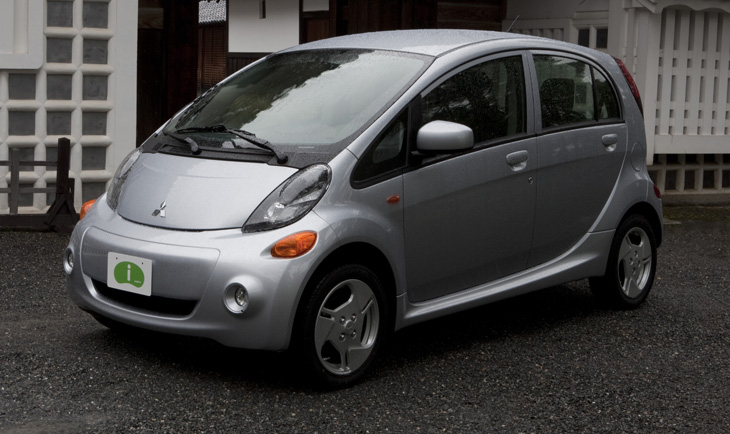

Key Specifications
Wheelbase:.......................................100.4 in.
Length:............................................144.8 in.
Height:.............................................63.6 in.
Width:..............................................62.4 in.
Curb weight:......................................2,595 lbs
Major Standard Features
•145/65 R15 front and 175/60 R15 rear low rolling resistant tires
•100-watt AM/FM/CD audio system with MP3/WMA playback capability and 4 speakers
•On-board recharging system with 120V portable 8 amp charging cable
•MiEV remote system (pre-activated air conditioning, heater and timer battery charging)
•Front ventilated disc and rear drum brakes with regenerative brake power system
•Speed-sensitive Electric Power Steering (EPS)
•Approaching Vehicle Audio System (AVAS) for alerting pedestrians
•Electric manual air conditioning with micron filter
•Electric compressor cabin heater
•Driver seat heater
•Advanced air bag system with dual-stage supplemental front air bags
•3-spoke steering wheel
•Driver and front-passenger seat-mounted side-impact supplemental air bags
•Roof-mounted curtain side-impact supplemental air bags for front and rear-seat outboard occupant protection
•Anti-lock brake system (ABS) with Electronic Brake-force Distribution (EBD), Brake Assist (BA) and brake override system
•Active Stability Control (ASC) with Traction Control Logic (TCL)
•Tire Pressure monitoring System (TPMS)
•High voltage cut-off system
•Engine immobilizer anti-theft system
•Remote keyless entry
•Power windows, locks and mirrors
•LED rear combination tail lamps
•50/50-split fold-down and recline rear seats
•Optional Cold Zone Package, includes Li-Ion battery Warming System, heated outer side mirrors
Mitsubishi i SE adds:
•15-in. alloy wheels
•360-watt, 8 speaker deluxe audio system
•Leather wrap steering wheel and shift knob
•Upgrade seating material
•Fog lamps with DRL function
•Auto on/off headlamps
•Silver interior accents
•2-tone instrument panel (brown/black)
•Passenger vanity mirror
•Optional Cold Zone package includes Li-Ion Battery Warming system, heated outer side mirrors
•Optional Premium package includes HDD navigation system with rearview camera monitor, FUSE Hands-free Link™ with USB port and steering
wheel-mounted audio controls, DC port for quick charger, Li-Ion Battery Warming system, heated outer side mirrors

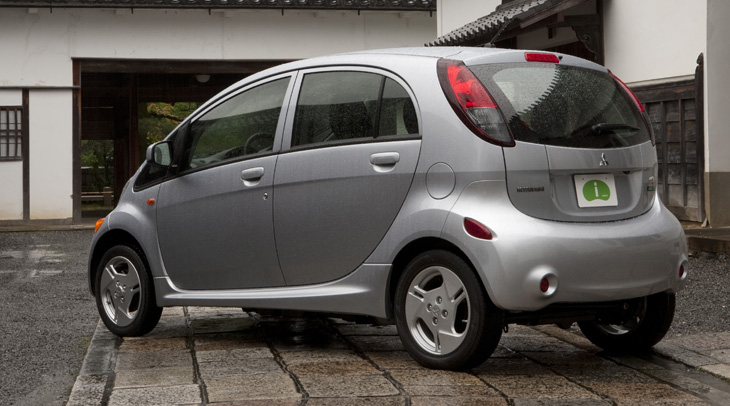
|

















